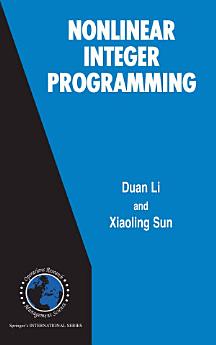Nonlinear Integer Programming
Duan Li · Xiaoling Sun
আগ ২০০৬ · International Series in Operations Research & Management Science বই 84 · Springer Science & Business Media
৩.০star
১টি রিভিউreport
ই-বুক
438
পৃষ্ঠা
reportরেটিং ও রিভিউ যাচাই করা হয়নি আরও জানুন
এই ই-বুকের বিষয়ে
It is not an exaggeration that much of what people devote in their hfe re solves around optimization in one way or another. On one hand, many decision making problems in real applications naturally result in optimization problems in a form of integer programming. On the other hand, integer programming has been one of the great challenges for the optimization research community for many years, due to its computational difficulties: Exponential growth in its computational complexity with respect to the problem dimension. Since the pioneering work of R. Gomory [80] in the late 1950s, the theoretical and methodological development of integer programming has grown by leaps and bounds, mainly focusing on linear integer programming. The past few years have also witnessed certain promising theoretical and methodological achieve ments in nonlinear integer programming. When the first author of this book was working on duality theory for n- convex continuous optimization in the middle of 1990s, Prof. Douglas J. White suggested that he explore an extension of his research results to integer pro gramming. The two authors of the book started their collaborative work on integer programming and global optimization in 1997. The more they have investigated in nonlinear integer programming, the more they need to further delve into the subject. Both authors have been greatly enjoying working in this exciting and challenging field.
রেটিং ও পর্যালোচনাগুলি
৩.০
১টি রিভিউ
ই-বুকে রেটিং দিন
আপনার মতামত জানান।
পঠন তথ্য
স্মার্টফোন এবং ট্যাবলেট
Android এবং iPad/iPhone এর জন্য Google Play বই অ্যাপ ইনস্টল করুন। এটি আপনার অ্যাকাউন্টের সাথে অটোমেটিক সিঙ্ক হয় ও আপনি অনলাইন বা অফলাইন যাই থাকুন না কেন আপনাকে পড়তে দেয়।
ল্যাপটপ ও কম্পিউটার
Google Play থেকে কেনা অডিওবুক আপনি কম্পিউটারের ওয়েব ব্রাউজারে শুনতে পারেন।
eReader এবং অন্যান্য ডিভাইস
Kobo eReaders-এর মতো e-ink ডিভাইসে পড়তে, আপনাকে একটি ফাইল ডাউনলোড ও আপনার ডিভাইসে ট্রান্সফার করতে হবে। ব্যবহারকারীর উদ্দেশ্যে তৈরি সহায়তা কেন্দ্রতে দেওয়া নির্দেশাবলী অনুসরণ করে যেসব eReader-এ ফাইল পড়া যাবে সেখানে ট্রান্সফার করুন।







